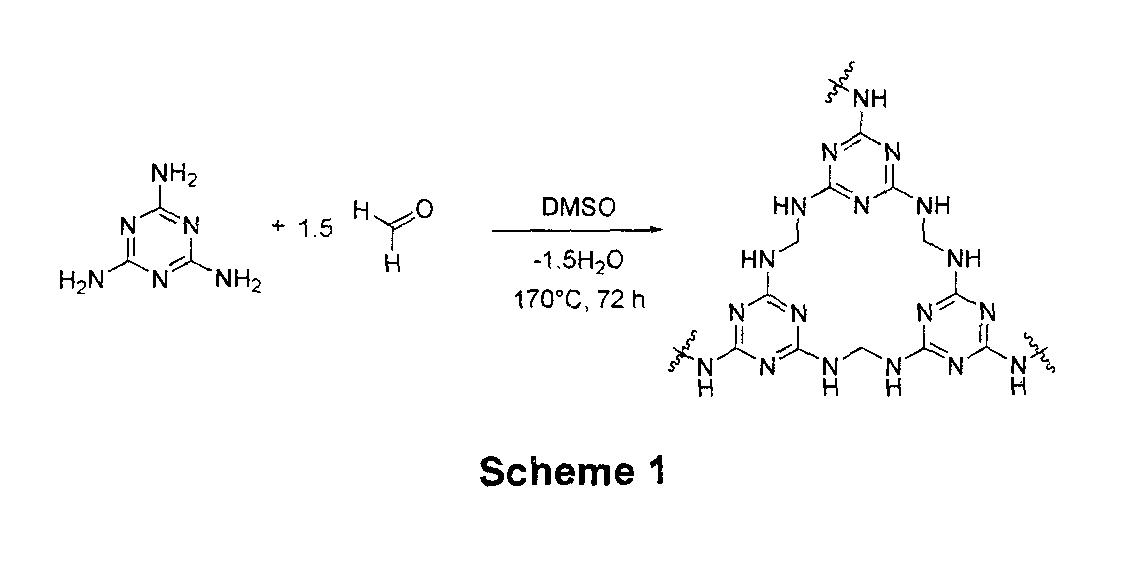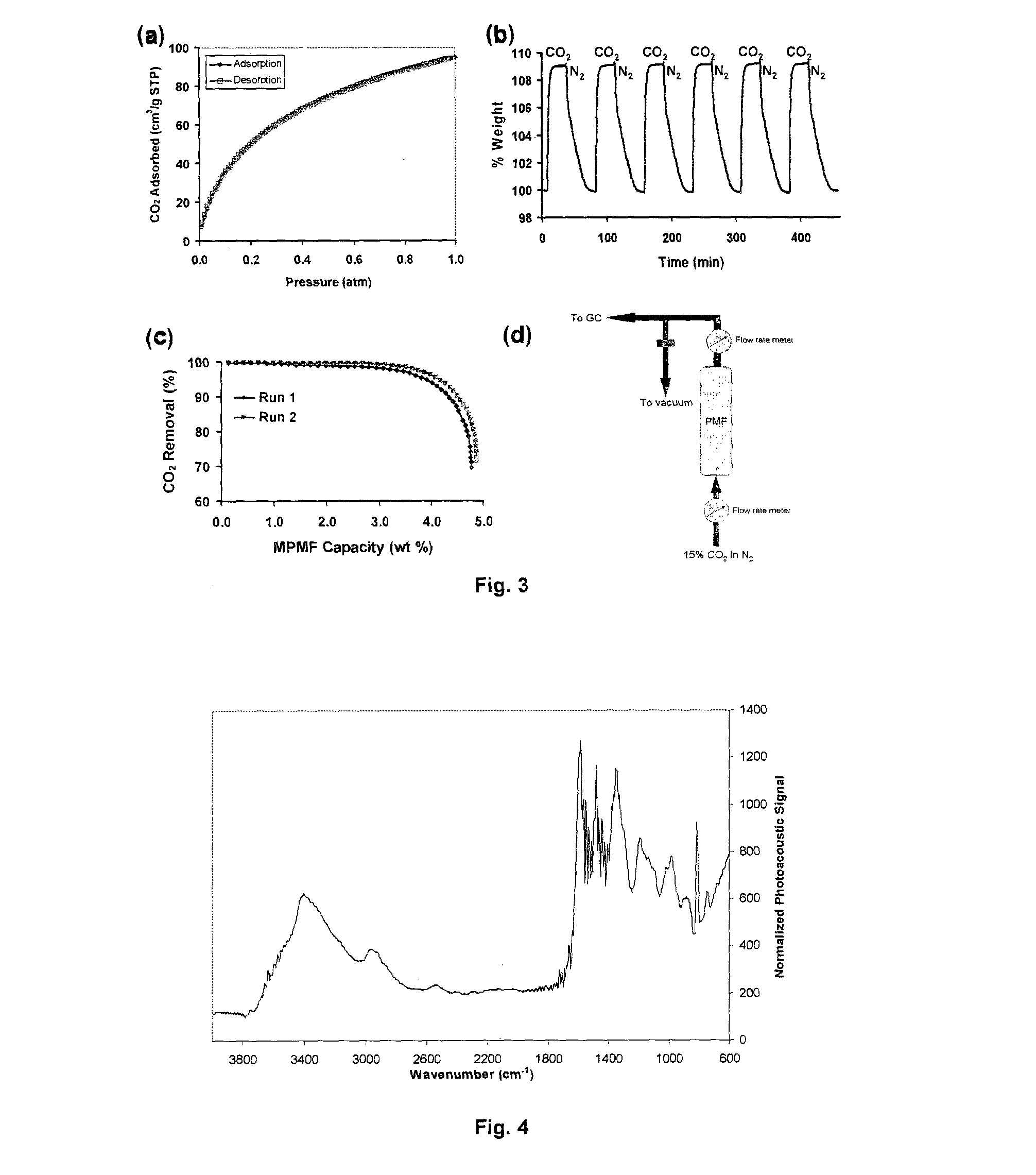Porous polymer material
a polymer material and porous technology, applied in the field of porous polymer materials, can solve the problems of limiting the application of amine in large scale industrial use, corrosive and volatile nature of amine and the aforementioned high energy penalty, and achieves stable polymer structure, low steric hindrance and bond strain in the polymer material, and high density of amine functional groups
- Summary
- Abstract
- Description
- Claims
- Application Information
AI Technical Summary
Benefits of technology
Problems solved by technology
Method used
Image
Examples
example 1
Mesoporous Melamine-Formaldehyde Co-polymers Synthesized on a Hot Plate
[0086]Melamine and paraformaldehyde were added to a 20-ml glass vial, followed by the addition of anhydrous DMSO. The reaction mixture was heated gradually to give a colorless solution. Further heating at 180° C. for 72 hrs resulted in the formation of a white solid. The solid was filtered, and washed with water (3×) and acetone (2×). The resulting solid was dried under vacuum at 80° C. for 24 h.
[0087]Using the above protocol, 8 samples of mesoporous PMF (Examples 1a to 1h) were prepared. The molar ratios of reactants, amount of solvent, reaction time and temperature for Examples 1a to 1h are provided in Table 1 below. The resulting samples were analyzed by nitrogen sorption at 77 K; surface area and pore diameter were obtained by the Brunauer-Emmet-Teller (BET) and Barrett-Joyner-Halenda (BJH) methods, respectively. Carbon dioxide sorption isotherm was analyzed at 273 K, and the results are also shown in Table 1...
example 2
Mesoporous Melamine-Formaldehyde Co-polymers Synthesized in an Oven
[0089]Melamine and paraformaldehyde were added to a 10 ml Teflon container with a magnetic stirrer, followed by addition of anhydrous DMSO. The Teflon container was capped and secured within a steel bomb reactor, which was heated to 120° C. in an oven (Memmert Universal UNE 400) for 1 hr. The bomb reactor was removed from the oven for stirring on a magnetic plate for 30 minutes to obtain a homogeneous solution. The bomb reactor was then heated again in the oven at 170° C. for 72 hours. The reactor was allowed to cool to room temperature, and the solid product obtained was crushed, filtered, and washed with DMSO, acetone (3×), THF (3×) and CH2Cl2. The resulting white solid was dried under vacuum at 80° C. for 24 hr.
[0090]12 different samples (Examples 2a to 2l) were produced based on the above described protocol. The molar ratios of reactants, solvent volume are provided in Table below. The samples were analyzed accor...
example 3
Mesoporous Melamine-Formaldehyde Co-polymers Synthesized Using a Solvent Admixture of DMSO and H2O
[0092]Paraformaldehyde and melamine were mixed in a molar ratio of 3:1 and reacted in the presence of a solvent admixture comprising DMSO and H2O. The total concentration of the reactants was 2.0 M and the overall reaction was performed in a bomb reactor that was heated in an oven for 72 hrs.
[0093]7 samples (Examples 3a-3g) of mesoporous PMF were produced using the above described protocol. The volume ratio of DMSO to H2O, oven temperatures were varied according to Table 3. The product samples were analyzed according to the analytical methods mentioned in example 1, with the results also shown in Table 3 below.
[0094]
TABLE 3N2 Adsorption at 77KReaction ConditionsBETBJHTotalCO2DMSO / H2OSurfacePorePoreMicroporeAdsorptionVolumeAreaDiameterVolumeVolumeCapacitycSampleRatioTemp. (° C.)(m2 / g)(nm)(cm3 / g)(cm3 / g)(wt %)3-a1:314011.967.90.140.0027.33-b1:114058110.00.460.1815.93-c3:11409967.11.360.121...
PUM
| Property | Measurement | Unit |
|---|---|---|
| size | aaaaa | aaaaa |
| temperatures | aaaaa | aaaaa |
| bond energies | aaaaa | aaaaa |
Abstract
Description
Claims
Application Information
 Login to View More
Login to View More - R&D
- Intellectual Property
- Life Sciences
- Materials
- Tech Scout
- Unparalleled Data Quality
- Higher Quality Content
- 60% Fewer Hallucinations
Browse by: Latest US Patents, China's latest patents, Technical Efficacy Thesaurus, Application Domain, Technology Topic, Popular Technical Reports.
© 2025 PatSnap. All rights reserved.Legal|Privacy policy|Modern Slavery Act Transparency Statement|Sitemap|About US| Contact US: help@patsnap.com



